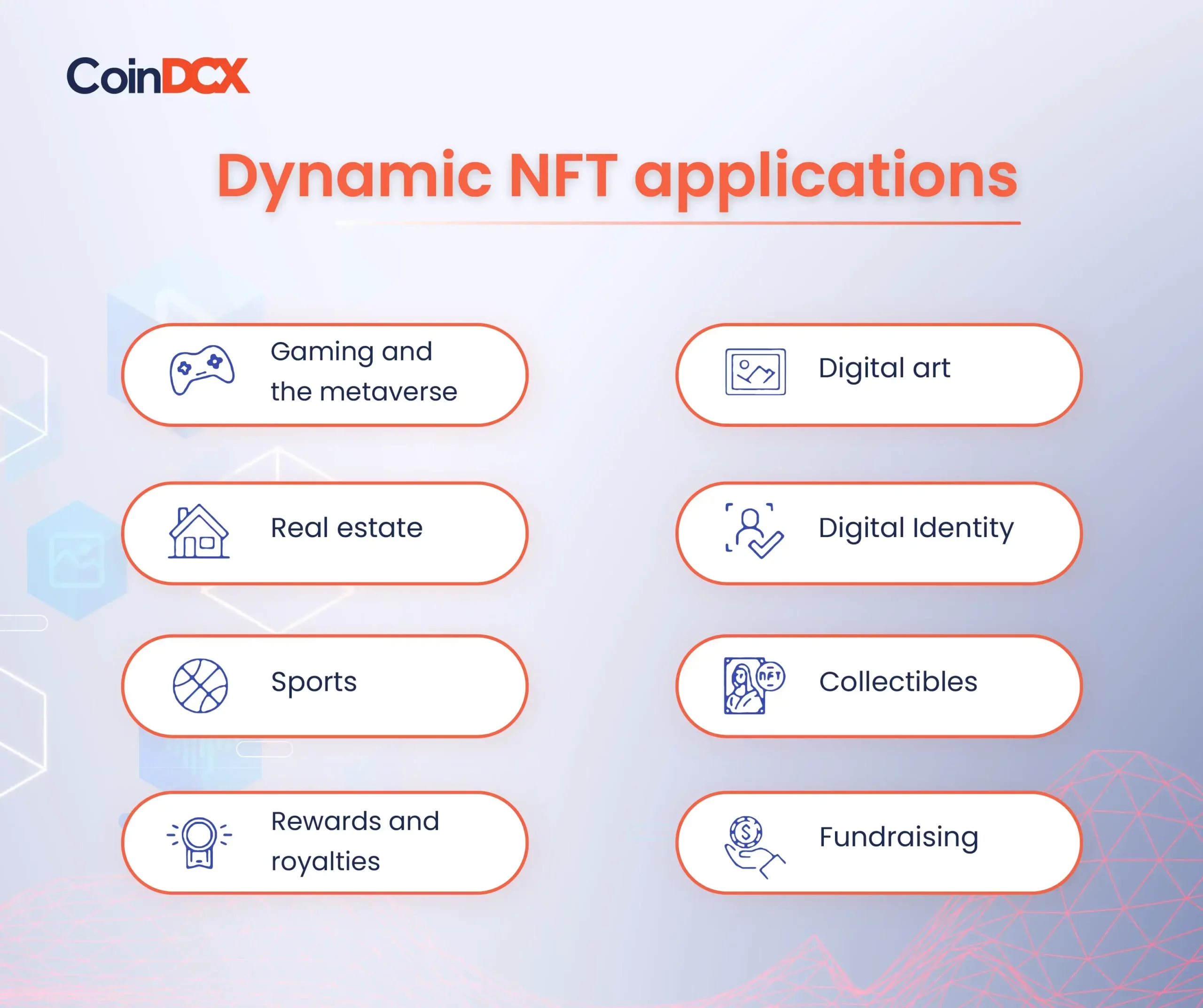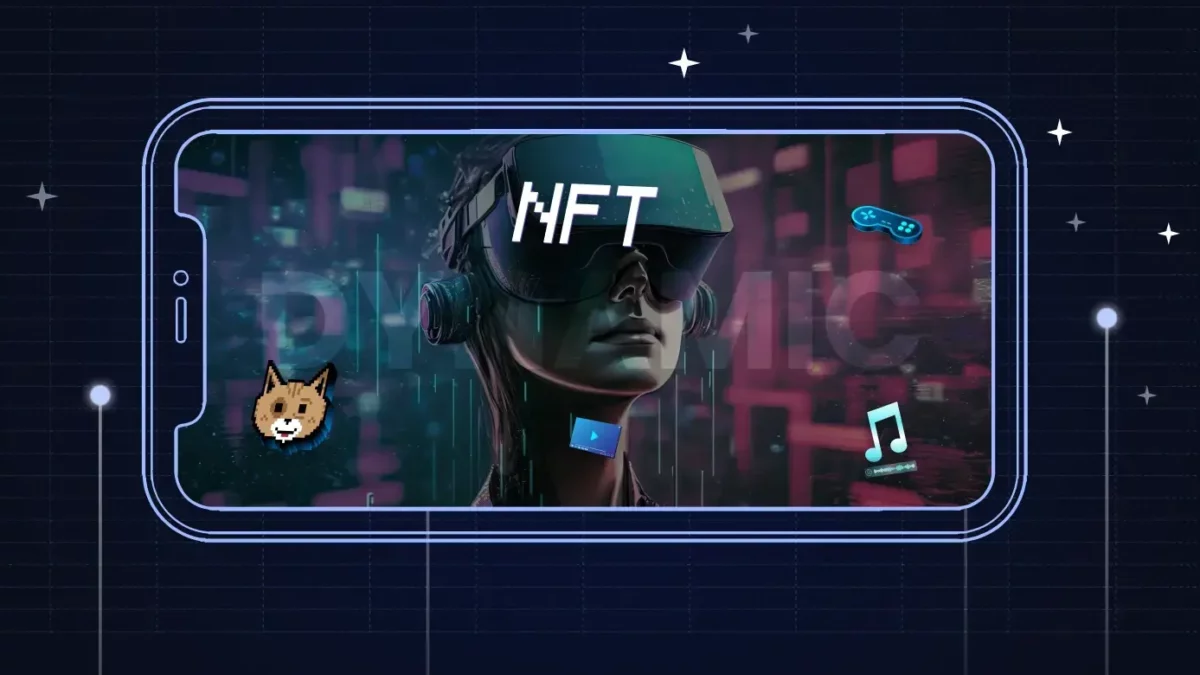Table of Contents
ToggleIntroduction
Following the extensive adoption within the Web3 community, Non-Fungible Tokens (NFTs) are now entering the mainstream arena, gaining significant attention from major media sources and witnessing numerous high-profile athletes and public figures collaborating for their unique collections. Consequently, NFTs have now become one of the most interestingly adopted applications of blockchain technology.
Data from Statista shows that the revenue from NFTs is set to sore high and read a whopping $1601 million dollars in 2023. With new collections being launched, like the CR7 with Binance, the new developments in the NFT space just getting started, it seems.
Dynamic NFTs, or dNFTs, are broadening the scope of possibilities within the NFT realm by their capacity to adjust and transform in reaction to external occurrences and data inputs.
Within this piece, we delve into the fundamentals of NFTs and explore the evolutionary potential introduced by dynamic NFTs.
What is an NFT in Crypto?
A Non-Fungible Token (NFT) is a digital asset that represents ownership or proof of authenticity of a unique item, piece of content, or collectible on a blockchain. Unlike crypto assets such as Bitcoin or Ethereum, NFTs are non-interchangeable, as each one is distinct and cannot be exchanged on a one-to-one basis with another NFT.
They have gained popularity for their application in art, music, gaming, and various digital creations, providing creators and collectors with a secure and transparent way to buy, sell, and trade digital goods while ensuring provenance and scarcity. NFTs have opened up new possibilities for digital ownership and the monetization of digital creations in the digital age.
Additional Read: How to Create NFTs for Free?
What are dNFTs?
Dynamic NFTs, also known as programmable or interactive NFTs, are a type of non-fungible token (NFT) that goes beyond the static digital representations that most NFTs offer. While traditional NFTs are essentially digital collectibles or representations of unique items, dynamic NFTs have the capability to change, adapt, or respond to external stimuli. They introduce a level of interactivity and functionality to the world of non-fungible tokens.
Here are some key features of dynamic NFTs:
- Interactivity: Dynamic NFTs can respond to user interactions or other variables. This might include animations, changes in appearance, or other dynamic elements triggered by user input.
- External Data: Some dynamic NFTs are linked to external data sources, such as real-time weather data, crypto prices, or social media trends. These NFTs can change in response to the data they are connected to.
- Utility: Dynamic NFTs can have utility beyond being digital art. They might grant access to certain online content, serve as game assets, or even provide access to physical items or experiences.
- Customization: Owners of dynamic NFTs may have the ability to customize or personalize the NFT, allowing them to make unique alterations or adaptations to the underlying digital asset.
- Smart Contracts: The functionality of dynamic NFTs is often made possible through the use of smart contracts on blockchain platforms like Ethereum. These contracts can execute code and trigger changes in the NFT’s properties.
- Real-World Integration: Some dynamic NFTs are used in combination with real-world objects or assets. For example, an NFT might represent a piece of art and grant its owner access to the physical artwork or unique benefits related to it.
- Gamification: Dynamic NFTs can be used in gaming applications, where in-game assets are NFTs that can evolve, be upgraded, or traded.
What are the Uses of Dynamic NFT?

How Do dNFTs Work?
Dynamic NFTs, where the static nature of conventional NFTs gives way to a dynamic and interactive experience, not only represent ownership but also possess the ability to evolve, adapt, and interact with external data, all driven by the power of smart contracts. Following steps in how they work;
- NFTs, including dynamic ones, use advanced blockchain tech to verify ownership and authenticity.
- Dynamic NFTs have artist-defined rules encoded as code, allowing them to change over time.
- The key difference is the token standard: dynamic NFTs use ERC-1155, editable, while static NFTs use ERC-721, uneditable.
- Smart contracts in dynamic NFTs automate changes, like appearance and user interactions.
- Dynamic NFTs use oracles for data updates via smart contracts.
- Smart contracts also control buying, selling, trading, and royalty distribution for dynamic NFTs via crypto wallets.
Read More: What is ERC-6551, NFT Standard?
4 Benefits of Dynamic NFTs
Dynamic NFTs introduce a range of compelling advantages to the world of non-fungible tokens, enhancing the traditional NFT experience and opening doors to novel possibilities. These benefits extend across interactivity, programmability, versatility, and revenue generation, offering unique prospects for artists, collectors, and creators alike. Let’s explore these advantages that dNFTs bring into the picture:
- Interactivity: Dynamic NFTs offer a heightened level of interactivity, making them more engaging and captivating for audiences. Their flexibility and ability to change over time introduce novel creative expressions and immersive experiences.
- Programmability: The programmable nature of dynamic NFTs empowers creators to define rules governing NFT behavior. This automation and control enable diverse use cases, extending into various industries. For instance, dynamic NFTs in gaming can represent evolving characters or items based on player progress.
- Versatility: Dynamic NFTs transcend the boundaries of digital art, finding utility in gaming, social networks, and a wide array of services. This versatility sparks innovation, allowing developers and creators to craft immersive experiences, enriching user interactions.
- New Revenue Streams: Dynamic NFTs offer artists and creators exciting, long-term revenue streams. Through ongoing royalties earned from NFT interactions and use, creators can derive sustainable income from their digital assets, incentivizing continued creativity and participation in the NFT ecosystem.
Static NFT vs Dynamic NFT: The Basic Differences
| Aspect | Static NFT | Dynamic NFT |
|---|---|---|
| Nature | Fixed, unchangeable data | Evolving, changeable data |
| Token Standard | Often ERC-721 | Typically ERC-1155 |
| Interactivity | Limited or static | A high degree of interactivity |
| Programmability | Limited programmability | Highly programmable, with defined rules |
| External Data | Typically not linked to external data | Can respond to external data through oracles |
| Use Cases | Mainly digital art, collectibles | Extends to gaming, social networks, and diverse applications |
| Utility | Often serves as digital collectibles | Used for in-game assets, virtual experiences, and more |
| Smart Contracts | Less reliant on complex smart contracts | Heavily dependent on smart contracts for automation |
| Revenue for Creators | The initial sale generates revenue | Ongoing royalties from interactions provide sustainable income |
| Long-Term Value | Value often tied to initial purchase | Potential for value growth as NFTs evolve and engage users |
| User Engagement | Limited interaction beyond ownership | Offers dynamic, engaging experiences to users |
Examples of Dynamic NFTs
The crypto space features a wide array of dynamic NFT examples, ranging from evolving gaming items tied to player progress to digital artworks transformed by collectors, time, or environmental factors. Some of the notable examples of dNFTs are as mentioned below:
- A pioneering instance of dynamic NFTs was Mike Winkelman’s “Crossroad” NFT, which was designed to alter its appearance based on the outcome of the 2020 U.S. presidential election. Following Joe Biden’s victory, it depicted former President Donald Trump differently.
CROSSROAD
By @beepleThe #1/1 from beeple’s first NG drop has just resold on the secondary market for $6.6 million.
History has just been made.
Congrats to beeple and of course to @pablorfraile for the sale. pic.twitter.com/mTYG4VABSw
— Nifty Gateway 🌐 (@niftygateway) February 25, 2021
- Cryptokitties, a well-known NFT-based game, serves as yet another illustration of dynamic NFTs. Within this game, participants have the opportunity to purchase, trade, or mate digital cats. Each cat is embodied as a dynamic NFT, granting owners the capacity to modify certain attributes linked to the token, including the cat’s genetic makeup, temperament, and physical characteristics.
Only 24 hours left to breed a Pawzilla! Breeding cuts off on September 27th at 12:00 PM PDT. This is a Fancy Cat, which requires a special recipe in order to be bred! Learn more here: https://t.co/sYuc0V1TAv pic.twitter.com/9ne5z2CGdG
— CryptoKitties (@CryptoKitties) September 26, 2018
- LaMelo Ball’s dynamic NFT collectibles maintain records of the professional basketball player’s game statistics and change in response to updates in points scored, rebounds, and assists.
NEW: LaMelo Ball (@MELOD1P), who is expected to be named NBA Rookie of the Year on Wednesday, is testing the largely uncharted waters of “dynamic” NFTs with @ether_cards and @chainlink.@elitanjourno reportshttps://t.co/87ThGVwIWh
— CoinDesk (@CoinDesk) June 16, 2021
Know More: Top NFT Tokens by Market Cap
The Future of Dynamic NFTs
Dynamic NFTs hold vast potential in revolutionizing non-fungible tokens across sectors like gaming, art, digital identity, and fundraising. In short, the potential for the future development and adoption of dynamic NFTs appears boundless. Representing a pioneering innovation in the digital asset landscape, the ability of dNFTs to evolve, enhance interactivity, and find applications in various fields, from gaming to art, marks just the beginning.
As the dynamic NFT technology and ecosystems advance, they are set to play a central role in shaping digital ownership and value exchange. Creators, collectors, and tech enthusiasts should closely monitor this captivating trend to tap in, at the right moment.
Related posts
Understanding the Different Types of Cryptos: Coins, Tokens, Altcoins & More Explained
Explore the major types of crypto assets and their unique roles.
Read more
PAWS Telegram Game: The New Tap to Earn Game That Is Beating Hamster Kombat
Discover how to play and earn with PAWS Telegram game.
Read more


